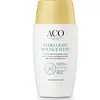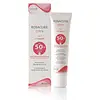What's inside
What's inside
 Key Ingredients
Key Ingredients

 Benefits
Benefits

 Concerns
Concerns

 Ingredients Side-by-side
Ingredients Side-by-side

Water
Skin ConditioningEthylhexyl Salicylate
UV AbsorberDibutyl Adipate
EmollientPropanediol
SolventTris-Biphenyl Triazine
UV AbsorberDiethylamino Hydroxybenzoyl Hexyl Benzoate
UV FilterSilica
AbrasiveDiisopropyl Sebacate
EmollientEthylhexyl Triazone
UV Absorber1,2-Hexanediol
Skin ConditioningBis-Ethylhexyloxyphenol Methoxyphenyl Triazine
Skin ConditioningBis-Ethylhexyl Hydroxydimethoxy Benzylmalonate
AntioxidantCetyl Alcohol
EmollientTocopheryl Acetate
AntioxidantPotassium Cetyl Phosphate
EmulsifyingSodium Hyaluronate
HumectantSarcosine
Skin ConditioningDecyl Glucoside
CleansingVp/Eicosene Copolymer
Butylene Glycol
HumectantXanthan Gum
EmulsifyingPentylene Glycol
Skin ConditioningCarbomer
Emulsion StabilisingDisodium Phosphate
BufferingCitric Acid
BufferingSodium Benzoate
MaskingWater, Ethylhexyl Salicylate, Dibutyl Adipate, Propanediol, Tris-Biphenyl Triazine, Diethylamino Hydroxybenzoyl Hexyl Benzoate, Silica, Diisopropyl Sebacate, Ethylhexyl Triazone, 1,2-Hexanediol, Bis-Ethylhexyloxyphenol Methoxyphenyl Triazine, Bis-Ethylhexyl Hydroxydimethoxy Benzylmalonate, Cetyl Alcohol, Tocopheryl Acetate, Potassium Cetyl Phosphate, Sodium Hyaluronate, Sarcosine, Decyl Glucoside, Vp/Eicosene Copolymer, Butylene Glycol, Xanthan Gum, Pentylene Glycol, Carbomer, Disodium Phosphate, Citric Acid, Sodium Benzoate
Water
Skin ConditioningDicaprylyl Carbonate
EmollientDiethylamino Hydroxybenzoyl Hexyl Benzoate
UV FilterC12-15 Alkyl Benzoate
AntimicrobialDimethyl Sulfone
SolventC20-22 Alkyl Phosphate
EmulsifyingC20-22 Alcohols
Emulsion StabilisingMethylene Bis-Benzotriazolyl Tetramethylbutylphenol
UV FilterEthylhexyl Triazone
UV AbsorberMethylpropanediol
SolventBis-Ethylhexyloxyphenol Methoxyphenyl Triazine
Skin ConditioningTriacontanyl Pvp
HumectantTris-Biphenyl Triazine
UV AbsorberGlycerin
Humectant4-T-Butylcyclohexanol
MaskingMagnolol
AntioxidantSodium Polyglutamate
HumectantTriethyl Citrate
MaskingCetearyl Alcohol
EmollientPentylene Glycol
Skin ConditioningHydroxyethylcellulose
Emulsion StabilisingCetearyl Glucoside
EmulsifyingSodium Hydroxide
BufferingPentaerythrityl Tetra-Di-T-Butyl Hydroxyhydrocinnamate
AntioxidantXanthan Gum
EmulsifyingPropylene Glycol
HumectantDecyl Glucoside
CleansingCaprylyl Glycol
EmollientDisodium Phosphate
BufferingButylene Glycol
HumectantWater, Dicaprylyl Carbonate, Diethylamino Hydroxybenzoyl Hexyl Benzoate, C12-15 Alkyl Benzoate, Dimethyl Sulfone, C20-22 Alkyl Phosphate, C20-22 Alcohols, Methylene Bis-Benzotriazolyl Tetramethylbutylphenol, Ethylhexyl Triazone, Methylpropanediol, Bis-Ethylhexyloxyphenol Methoxyphenyl Triazine, Triacontanyl Pvp, Tris-Biphenyl Triazine, Glycerin, 4-T-Butylcyclohexanol, Magnolol, Sodium Polyglutamate, Triethyl Citrate, Cetearyl Alcohol, Pentylene Glycol, Hydroxyethylcellulose, Cetearyl Glucoside, Sodium Hydroxide, Pentaerythrityl Tetra-Di-T-Butyl Hydroxyhydrocinnamate, Xanthan Gum, Propylene Glycol, Decyl Glucoside, Caprylyl Glycol, Disodium Phosphate, Butylene Glycol
Ingredients Explained
These ingredients are found in both products.
Ingredients higher up in an ingredient list are typically present in a larger amount.
You might know this ingredient as Tinosorb S or Bemotrizinol. It is a UV filter that covers both UVA and UVB rays.
This ingredient has two peak UV absorption peaks ( 310 and 340 nm) and is able to absorb both UV-A and UV-B rays. This ingredient works by preventing UV rays from reaching and damaging your skin.
On top of that - it is highly photostable and helps prevent the photodegration of other sunscreen ingredients such as avobenzone.
Tinosorb S is allowed in the EU, Australia, and Asia. It is close to being approved by the FDA and we'll hopefully get this ingredient in the U.S. by late 2025.
Fun fact: Tinosorb S is the most effective UV absorber at maximum concentration (measured by SPF) permitted in the EU.
This ingredient is oil-soluble, so your oil-cleansers will take this right off at night.
Learn more about Bis-Ethylhexyloxyphenol Methoxyphenyl TriazineButylene Glycol (or BG) is used within cosmetic products for a few different reasons:
Overall, Butylene Glycol is a safe and well-rounded ingredient that works well with other ingredients.
Though this ingredient works well with most skin types, some people with sensitive skin may experience a reaction such as allergic rashes, closed comedones, or itchiness.
Learn more about Butylene GlycolDecyl Glucoside is a glucose-based surfactant and emulsion stabilizer. It is created by reacting glucose with the fatty acids from plants.
Surfactants help clean the skin by trapping oil, sebum, and dirt to be washed away. As an emulsion stabilizer, it stabilizes the ingredients in a product by preventing them from separating.
This ingredient is biodegradable and non-toxic. This ingredient is commonly found in baby shampoos.
Decyl Glucoside is sometimes used to stabilize the UV filter Tinosorb.
Learn more about Decyl GlucosideDiethylamino Hydroxybenzoyl Hexyl Benzoate (DHHB) is a chemical UV-A absorber. It is formulated for high UVA protection (320-400 nm).
DHHB is well-liked for:
DHHB has been approved by the EU, Japan, Taiwan, and South America for use up to 10%. Unfortunately, it has not been approved for use in the US or Canada due to slow regulatory processes.
This ingredient is soluble in oils, fats, and lipids.
Learn more about Diethylamino Hydroxybenzoyl Hexyl BenzoateDisodium Phosphate is a water-soluble powder used as a pH adjuster.
Ethylhexyl Triazone is a modern chemical sunscreen that protects from UV-B radiation.
It is the most effective of existing UV-B filters, as it provides the highest level of photo-stable absorption. It protects from the entire UV-B range (280 to 320nm), with it's highest level of protection at 314nm.
Ethylhexyl Triazone is oil soluble, oderless and colorless, which mean it is able to be incorporated into a variety of different formulations.
It is not currently available within the United States due to slow changing FDA regulations. Outside of the US, it is used in formulations at concentrations up to 5%.
Learn more about Ethylhexyl TriazonePentylene glycol is typically used within a product to thicken it. It also adds a smooth, soft, and moisturizing feel to the product. It is naturally found in plants such as sugar beets.
The hydrophilic trait of Pentylene Glycol makes it a humectant. As a humectant, Pentylene Glycol helps draw moisture from the air to your skin. This can help keep your skin hydrated.
This property also makes Pentylene Glycol a great texture enhancer. It can also help thicken or stabilize a product.
Pentylene Glycol also acts as a mild preservative and helps to keep a product microbe-free.
Some people may experience mild eye and skin irritation from Pentylene Glycol. We always recommend speaking with a professional about using this ingredient in your routine.
Pentylene Glycol has a low molecular weight and is part of the 1,2-glycol family.
Learn more about Pentylene GlycolTinosorb A2B is a UV-B and UV-A sunscreen filter (290 - 340 nm). This ingredient is photo-stable and water-soluble.
According to studies done by the manufacturer, it is the most effective UVB and UV-A 2 sunscreen filter to date.
It is mostly effective at protecting in the UV-A 2 (315-340 nm) range but has a boosting effect in the UV-A 1 (340 - 400 nm) range.
This ingredient is currently available in the EU and Asia, but is awaiting approval in the US and Canada.
Learn more about Tris-Biphenyl TriazineWater. It's the most common cosmetic ingredient of all. You'll usually see it at the top of ingredient lists, meaning that it makes up the largest part of the product.
So why is it so popular? Water most often acts as a solvent - this means that it helps dissolve other ingredients into the formulation.
You'll also recognize water as that liquid we all need to stay alive. If you see this, drink a glass of water. Stay hydrated!
Learn more about WaterXanthan gum is used as a stabilizer and thickener within cosmetic products. It helps give products a sticky, thick feeling - preventing them from being too runny.
On the technical side of things, xanthan gum is a polysaccharide - a combination consisting of multiple sugar molecules bonded together.
Xanthan gum is a pretty common and great ingredient. It is a natural, non-toxic, non-irritating ingredient that is also commonly used in food products.
Learn more about Xanthan Gum